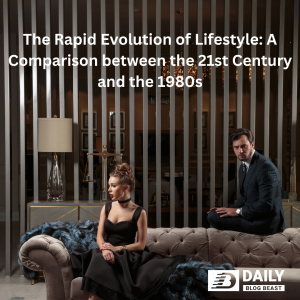Introduction:
The 21st century has witnessed a remarkable transformation in lifestyle, driven by technological advancements, cultural shifts, and global connectivity. This essay explores the rapid changes that have occurred in people’s way of life over the past few decades, highlighting the stark contrasts between the 21st century and the 1980s. From communication to entertainment, work-life balance to health and well-being, every aspect of our existence has experienced a profound evolution.
Technological Revolution:
One of the most significant factors responsible for the rapid lifestyle changes in the 21st century is the technological revolution. In the 1980s, personal computers were just emerging, and the internet was a nascent concept. Today, we live in an interconnected world where smartphones have become an extension of ourselves, providing instant access to information, communication, and entertainment. The advent of social media platforms and messaging apps has revolutionized how we connect with others, transcending geographical boundaries and making communication instantaneous.
Communication and Connectivity:
In the 1980s, communication was limited to landline phones, fax machines, and traditional mail. Long-distance calls were expensive, and letters took days or weeks to reach their recipients. In contrast, the 21st century has witnessed an explosion of communication options. Email, instant messaging, video calls, and social media have made communication faster, more efficient, and highly accessible. People can now connect with loved ones, friends, and colleagues across the globe with a few taps on their smartphones.
Work and Productivity:
The nature of work has also undergone a significant transformation. In the 1980s, the traditional 9-to-5 office job was the norm, with limited options for remote work. Today, flexible work arrangements, remote work, and the gig economy have gained prominence. Advancements in technology have facilitated a shift towards remote collaboration, allowing individuals to work from anywhere at any time. The rise of freelancing platforms and digital marketplaces has empowered people to pursue alternative careers and embrace a more flexible work-life balance.
Entertainment and Media Consumption:
The way we entertain ourselves has evolved dramatically. In the 1980s, television, radio, and print media dominated the entertainment landscape. Families would gather around the television for their favorite shows, and physical media like VHS tapes and cassettes were popular for movies and music. Today, streaming services like Netflix, YouTube, and Spotify have revolutionized media consumption. We have access to an unprecedented array of content on-demand, personalized to our preferences, and accessible on various devices. The rise of digital content creation has also given birth to new forms of entertainment, such as vlogging, podcasting, and online gaming.
Health and Well-being:
The focus on health and well-being has seen a significant shift between the 1980s and the 21st century. In the 1980s, smoking was prevalent, fitness was not a priority for many, and fast food consumption was on the rise. Today, there is a heightened awareness of the importance of maintaining a healthy lifestyle. Fitness trends, including gym memberships, yoga, and home workouts, have gained immense popularity. The availability of health-tracking wearables, smartphone apps, and online resources has empowered individuals to take charge of their well-being.
Social and Cultural Changes:
Social and cultural norms have also experienced profound changes. The 21st century has witnessed increased acceptance and recognition of diversity, gender equality, and LGBTQ+ rights. There is a greater emphasis on inclusivity, representation, and social justice. Social media platforms have provided a platform for marginalized voices to be heard, and online communities have formed around shared interests and causes. The rise of influencers and content creators has redefined celebrity culture and influenced consumer behavior.
Conclusion:
The lifestyle changes that have occurred between the 1980s and the 21st century are staggering. Technological advancements, especially in communication and connectivity, have redefined how we interact with others. Work-life balance has been reshaped by flexible work arrangements and remote opportunities. Entertainment and media consumption have become personalized and accessible. Health and well-being have become paramount, and cultural shifts have led to increased inclusivity and social awareness. As we move further into the 21st century, it is essential to adapt and embrace the evolving lifestyle while ensuring the balance between the benefits of technology and the preservation of our humanity.


